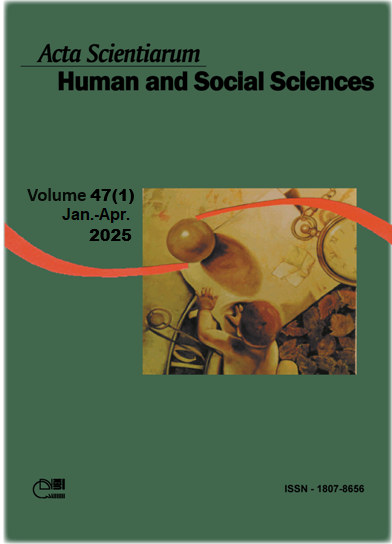Demonic Othernesses in Argentine politics. A journey through the state construction of otherness in Argentine history during the period of national organization (1860-1910) and the ‘National Reorganization Process’ (1976-1983) and the democratic transitio
Abstract
In the process of social and identity construction, otherness can be understood, defended or stigmatized. In this paper, I will address how difference was demonized throughout Argentine history. To this end, I will divide the analysis into two moments: the national organization and the national reorganization: the first one comprises the process of conformation of the national State (which we can locate between 1860 - 1910) in which we find, on the one hand, an ethnic otherness (indigenous and gauchos) and from 1900 onwards a political otherness (anarchism). In a second moment, we place the analysis of the process of civic-military dictatorship that proclaimed itself ‘process of national reorganization’ (1976-1983). In this period, we see a political otherness that constructs the image of the subversive criminal as an enemy of society. And finally, in the democratic transition (1983-1989) ‘the two demons’ as an explanation of what happened and the conformation of democracy in a new status quo. For this analysis, documentary, legislative and audiovisual sources will be analyzed in order to analyze from the public and political spheres how these models of alterities were constructed. The discursive and political way of constructing the negative other in the two processes considered foundational/foundational of the State will be analyzed. In this sense, we will analyze the use of expressions of demonization and otherness in the processes of organization/reorganization that generated constructs of political and physical violence on social collectives, in order to expel them from this budding nation.
Downloads
References
Adamovsky, E. (2012). El color de la nación argentina. Conflictos y negociaciones por la definición de un ethnos nacional, de la crisis al Bicentenario Jahrbuch für Geschichte Lateinamerikas, 49(1), 243-364.
Alberdi, J. B. (2010). Bases y puntos de partida para la organización política de la república Argentina. Editor Colihue.
Albornoz, M. (2019). La vigilancia del anarquismo en la prensa de Buenos Aires a comienzos del siglo XX. Revista Quinto Sol, 23(3), 1-21.
Álvarez, E. (2016). El movimiento anarquista como enemigo interno de la Nación: 1900-1910 [Ponencia]. Actas del 9º Seminario Internacional de Políticas de la Memoria do Centro Cultural Haroldo Conti, Buenos Aires, AR.
Anapios, L. (2011). Una promesa de folletos. El rol de la prensa en el movimiento anarquista en la Argentina (1890-1930). Acontracorriente, 8(2), 1-34.
Chiarini, S., & Portugheis, R. E. (2014). Plan conintes: represión política y sindical. Ministerio de Justicia y Derechos Humanos de la Nación.
Clastres, P. (1996). Sobre el etnocidio. In P. Clastres, Investigaciones en Antropología Política (pp. 55-64). Editor Gedisa.
Colosimo, A., & Segredo. M. (2018). La representación simbólica del genocidio. Un diagnóstico sobre su enunciación [Ponencia]. Actas del 11º Congreso Internacional de Políticas Públicas de Memoria,Centro Cultural de la Memoria Haroldo Conti, Buenos Aires, AR.
Comblin, J. (1978). El poder militar en América Latina. Editor Sígueme.
Comisión Nacional sobre la Desaparición de Personas [Conadep]. (1997). Nunca Más. Editor Eudeba.
Crenzel, E. (2008). Historia política del Nunca Más. Editor Siglo XXI.
Cuche, D. (2002). La noción de cultura en las ciencias sociales. Editor Nueva Visión.
Decretos Secretos y Reservados n. 261 de 5 de febrero de 1975. (1975). Decreto para neutralizar y/o aniquilar la subversión. https://www.argentina.gob.ar/normativa/nacional/decreto-261-1975-210287
Decreto N° 4161 05 de marzo de 1956. (1956). Prohibición de partidos políticos. https://www.argentina.gob.ar/normativa/nacional/decreto_ley-4161-1956-296876
Decreto N° 2772 del 6 de octubre de 1975.(1975). Ejecución de las operaciones militares y de seguridad necesarias para eliminar la subversión. https://www.resdal.org/caeef-resdal/assets/argentina----decreto-2772-del-6-de---octubre-de-1975.pdf
Di Meglio, G. (2006). Historia de las clases populares. Sudamericana.
Documentación adum. (1984). Documental ‘Nunca Más’ emitido por Canal 13 en el año 1984 [Vídeo]. YouTube. https://www.youtube.com/watch?v=HuuQ4WLQs2I
Duhalde, L.E. (2010). El terrorismo de Estado en la Argentina. Editor IEM
Ejercito Argentino. (1977). RC-9-1 - Operaciones contra elementos subversivos. www.mpf.gob.ar/plan-condor/files/2018/12/16-1.pdf
Feierstein, D. (2012). El genocidio como práctica social. Ed. Fondo de Cultura Económica.
Feld, C. (2007). Estrategias de construcción de testimonios audiovisuales sobre la desaparición de personas en Argentina: el programa televisivo ‘Nunca Más’. Documentos Lingüísticos y Literarios, 30(1), 1-11.
Fernández, A. (2017). La ley argentina de inmigración de 1876 y su contexto histórico. Almanack, Guarulhos, 1(17), 51-85. https://doi.org/10.1590/2236-463320171705
Franco, M. (2012). Un enemigo para la nación: orden interno, violencia y “subversión”, 1973-1976. Ed. Fondo de Cultura económica
Garaño, S. (2019). Ensayo del terrorismo de Estado en Argentina: el Operativo Independencia (Tucumán, 1975-1977). Boletín del Instituto de Historia Argentina y Americana Dr. Emilio Ravignani, 54(1), 137-162.
Guillard, A. (2018). Demonizar para castigar: justificar el castigo durante la última dictadura argentina (1976-1983). Revista Cahiers des Amériques Latines, 88(88-89), 135-151. https://doi.org/10.4000/cal.8923
Halperin Donghi, T. (1980). Una nación para el desierto argentino. Centro Editor de América Latina.
Ley 4144 de 22 de noviembre de 1902. (1902). Ley de residencia. https://servicios.infoleg.gob.ar/infolegInternet/verNorma.do;jsessionid=69C938CBE8198CD198D1D21D8A86D24E?id=285274
Ley 7029 de 28 de junio de 1910. (1910). Ley de Defensa Social. https://www.argentina.gob.ar/normativa/nacional/ley-7029-288825
Ley 817 de 6 de octubre de 1876. (1876). Ley de inmigración. www.educ.ar/app/files/repositorio/file/30/16/57f71b70-e955-11ea-a258-917480d9899c/contenido/materiales_para_formacion_docente/textos_de_consulta/18%20Ley%20817.pdf
Ley 13.234 de 01 de septiembre de 1948. (1948). Ley de defensa nacional. https://www.argentina.gob.ar/normativa/nacional/ley-13234-295707
Ley 20.840 de 28 de septiembre de 1974. (1974). Ley de seguridad Nacional. https://www.argentina.gob.ar/normativa/nacional/ley-20840-73268
Mapelman, V., & Musante, M. (2010). Campañas militares, reducciones y masacres: las prácticas estatales sobre los pueblos originarios del Chaco. In O. Bayer (Coord.), Historia de la crueldad argentina: Julio A. Roca y el genocidio de los pueblos originarios (pp. 241-280). Eitor El Tugurio.
Oszlak, O. (2010). La formación del estado argentino. Editor Ariel.
Perrone, J. (1974). Diario de la historia argentina. Tomo II. Ed. Latitudes.
Pomer, L. (2008). La guerra del Paraguay. Editor Leviatán.
Reid Andrews, G. (2008). Los afroargentinos de Buenos Aires. Ediciones de la Flor.
Risler, J. (2018). La acción psicológica: dictadura, inteligencia y gobierno de las emociones (1955-1981). Tinta Limón.
Sarmiento, D. F. (2011). Facundo: civilización y barbarie. Editor Eudeba.
Sticotti, J. (2018). El programa ‘Nunca Más’ de la Conadep: televisión, política y estética. Imagofagia, 1(18), 177-199.
Sujatovich, L. (2011) ¡Muerte al último tirano! Del fin del asedio a Paysandú a la primera semana de la guerra al Paraguay, en los editoriales de La Nación Argentina. https://www.academia.edu/26652865/Muerte_al_%C3%9Altimo_Tirano
Televisión Pública. (1977). Archivos históricos - Videla sobre ‘la subversión’ (1 de 2) [Vídeo]. YouTube. https://www.youtube.com/watch?v=_kRlioMt-pw
Valko, M. (2013). Pedagogía de la desmemoria: crónicas y estrategias del genocidio invisible. Peña Lillo.
Vezzetti, H (2012). Pasado presente: guerra, dictadura y sociedad en la Argentina. Editor Siglo XXI.
Zaragoza, R. (2015). El anarquismo argentino (1876-1902). De la Torre.
Copyright (c) 2025 Ayelen Colosimo

This work is licensed under a Creative Commons Attribution 4.0 International License.
DECLARATION OF ORIGINALITY AND COPYRIGHTS
I Declare that current article is original and has not been submitted for publication, in part or in whole, to any other national or international journal.
The copyrights belong exclusively to the authors. Published content is licensed under Creative Commons Attribution 4.0 (CC BY 4.0) guidelines, which allows sharing (copy and distribution of the material in any medium or format) and adaptation (remix, transform, and build upon the material) for any purpose, even commercially, under the terms of attribution.
Read this link for further information on how to use CC BY 4.0 properly.























